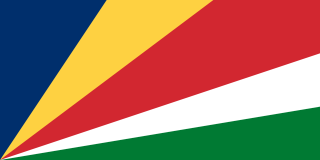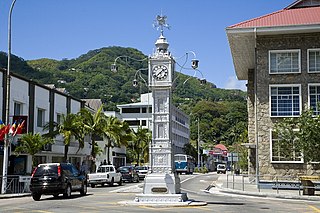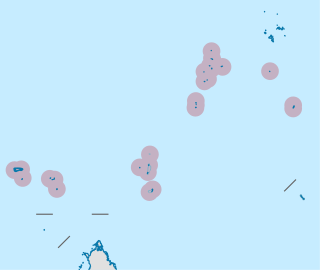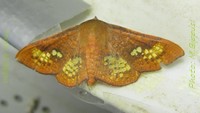Related Research Articles

Seychelles, officially the Republic of Seychelles, is an archipelagic state consisting of 115 islands in the Indian Ocean. Its capital and largest city, Victoria, is 1,500 kilometres east of mainland Africa. Nearby island countries and territories include the Comoros, Madagascar, Mauritius, and the French overseas departments of Mayotte and Réunion to the south; and Maldives and the Chagos Archipelago to the east. It is the least populated sovereign African country, with an estimated 2020 population of 98,462.

Seychelles is a small island country located in the Sea of Zanj due north of Madagascar, with Antsiranana as its nearest foreign city. Seychelles lies between approximately 4ºS and 10ºS and 46ºE and 54ºE. The nation is an archipelago of 115 tropical islands, some granite and some coral. the majority of which are small and uninhabited. The landmass is only 452 km2 (175 sq mi), but the islands are spread wide over an exclusive economic zone of 1,336,559 km2 (516,048 sq mi). About 90 percent of the population of 90,000 live on Mahé, 9 percent on Praslin and La Digue. Around a third of the land area is the island of Mahé and a further third the atoll of Aldabra.

Aldabra is the world's second-largest coral atoll, lying south-east of the continent of Africa. It is part of the Aldabra Group of islands in the Indian Ocean that are part of the Outer Islands of the Seychelles, with a distance of 1,120 km (700 mi) southwest of the capital, Victoria on Mahé Island.

Victoria is the capital and largest city of the Republic of Seychelles, situated on the north-eastern side of Mahé island, the archipelago's main island. The city was first established as the seat of the British colonial government. In 2010, the population of Greater Victoria was 26,450 (26.66%) out of the country's total population of 99,202.

Mahé is the largest island of Seychelles, with an area of 157.3 square kilometres (60.7 sq mi), lying in the northeast of the Seychellois nation in the Somali Sea part of the Indian Ocean. The population of Mahé was 77,000, as of the 2010 census. It contains the capital city of Victoria and accommodates 86% of the country's total population. The island was named after Bertrand-François Mahé de La Bourdonnais, a French governor of Isle de France.

The Outer Islands or Coralline Seychelles (archipelago) is a collective term for those islands of the Seychelles that are not on the shallow Seychelles Bank which defines the location of the granitic Inner Islands archipelago to the east. The local Seychellois Creole name for the outer islands is Zil Elwannyen Sesel, while the French name is Îles Eloignées. They are all of coral formation, and in the western Indian Ocean.

Islam in the Indian Ocean was established by Muslim sea merchants well before the European discovery of Seychelles. However, unlike in other island states including the Comoros and Maldives, there were no permanent inhabitants in Seychelles until the French settlement in 1770. Today, the Muslim population of the islands is reported to be only 1.1%, roughly 900 people. Many of its island neighbors in the southern Indian Ocean, including Comoros, the Maldives and Zanzibar, have a much larger Muslim influence because of their settlement by Muslims, before European colonization. Mauritius also has a much higher Muslim population due to the importation of labour from British India on a scale not seen in Seychelles. The government of Seychelles allows 15 minutes of religious broadcasting every Friday for the Muslim community.

The history of Seychelles dates back to the fourth of the Portuguese India Armadas led by Vasco da Gama, though Seychelles was likely already known to Arab navigators and other sailors for many centuries. On 15 March 1503, the scrivener Thomé Lopes noted the sighting of an elevated island, doubtless one of the granitic islands and almost certainly Silhouette Island. The first recorded landing was by the men of the English East India Company ship Ascension, which arrived in Seychelles in January 1609.The islands were claimed by France in 1756. Seychelles remained uninhabited until the first settlers arrived on board the ship Thélemaque, which arrived on 27 August 1770. Captain Leblanc Lecore landed the first colonists, comprising 15 white men, eight Africans and five Indians. The Seychellois Creole language developed as a means of communication between the different races. The British frigate Orpheus commanded by Captain Henry Newcome arrived at Mahé on 16 May 1794. Terms of capitulation were drawn up and the next day Seychelles was surrendered to Britain. Following the fall of Mauritius to British forces, Captain Phillip Beaver of the Nisus arrived at Mahé on 23 April 1811 and took possession of Seychelles as a permanent colony of Britain. The Seychelles became an independent republic in 1976. Following a coup d'état, a socialist one-party state ruled the country from 1977 to 1993. The subsequent democratic Presidential elections were won by candidates of the same party.

Utetheisa pulchelloides, the heliotrope moth, is a moth of the family Erebidae. It is found in the Indo-Australian region including Borneo, Hong Kong, New Zealand, Papua, Seychelles, most of Australia and Tenerife. The species was first described by George Hampson in 1907.

Anatrachyntis is a genus of moths in the family Cosmopterigidae. Some authors include it in Pyroderces.

The Seychelles Microcontinent is a microcontinent underlying Seychelles in the western Indian Ocean made of Late Precambrian rock.

Banisia clathrula is a species of moth of the family Thyrididae. It is found in Mauritius and Réunion.

Banisia is a genus of moths of the family Thyrididae.

Banisia myrsusalis, the sapodilla borer or sapota midrib folder, is a species of moth of the family Thyrididae. It was described by Francis Walker in 1859 and is found in North America, Brazil, Australia, southern Asia and Africa.
Banisia aldabrana is a species of moth of the family Thyrididae. It is found in the Seychelles on the islands of Aldabra, Menai and Cosmoledo and in South Africa.
Banisia apicale is a species of moth of the family Thyrididae. It is found in the Seychelles on Silhouette Island.
Banisia lobata is a moth of the family Thyrididae first described by Frederic Moore in 1882. It is found in India, Sri Lanka, Malaysia, China, Hong Kong and Brunei.
References
- ↑ afromoths.net
- ↑ Fryer, 1912. The Lepidoptera of Seychelles and Aldabra. - Transactions of the Linnean Society of London (2)15(Zool.)(1):20-21; pl.1 fig.16